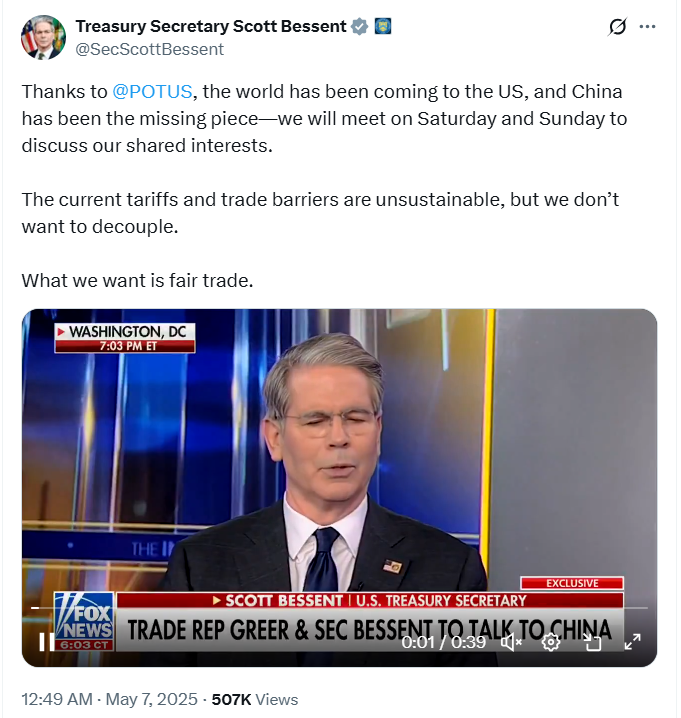Trade War Tremors: Stocks Stumble While Crypto Defies Gravity
As US-China tariffs escalate, traditional markets wobble—but Bitcoin and altcoins chart their own course. Here’s why digital assets might be the ultimate hedge against geopolitical chaos.
Wall Street’s sweating over soybean tariffs? Crypto traders barely blinked. While the S&P 500 seesawed on trade war headlines last week, Bitcoin held steady above $60K—proving once again that decentralized assets dance to their own beat.
Goldman analysts call it ’irrational divergence.’ Crypto natives call it Tuesday. When nation-states play economic chicken, permissionless networks keep humming along. Just don’t tell the SEC.
Bonus jab: Meanwhile in traditional finance, your 401(k) is getting rebalanced into Chinese debt instruments. Enjoy that 2% yield while it lasts.

The US stock and crypto markets are showcasing a diverging trend amid possible trade war discussions between the US and China.
Notably, the price of the S&P 500 stock market has dropped on the daily chart. In contrast, top cryptocurrencies, including Bitcoin (BTC), ethereum (ETH), and Solana (SOL), are experiencing a bullish revival.
The US-China Trade Talk Outlook
Numerous reports have suggested that the US and Chinese officials are set to start talks this week to try to de-escalate the ongoing trade war.
US Treasury Secretary Scott Bessent revealed plans to talk with Chinese Vice Premier He Lifeng during his visit to Switzerland from May 9 to 12.

The main objective of this meeting is to establish the conditions for a potential settlement.
Since tariff escalation kicked off in March, the trade talks WOULD be the first in-person meeting between Chinese and American officials.
Upon returning to the White House, US President Donald TRUMP imposed new import taxes of up to 145% on Chinese goods.
In response, Beijing had imposed 125% levies on some goods from the US. The punishing tariffs have already damaged both economies, leading to a dramatic trade drop between the two countries.
Therefore, many see the de-escalation of the trade war as a welcome sign for businesses and consumers in both countries and around the globe.
However, optimistic sentiments for a potential settlement are gradually fading. Treasury Secretary Bessent noted that trade talks with China are not “advanced.”
S&P 500, Dow Jones, and Nasdaq React
This statement resulted in the stock market trading in the red zone during today’s trading session peak.
The value of the S&P 500 fell sharply by over 2% within the past 24 hours to $5,604. Similarly, the Dow Jones Industrial Average fell 2.2%, while the Nasdaq Composite dropped 1.5%.
Bessent’s comments on stalled China trade talks fueled uncertainty, leading to price drops in the US stock market.
Experts fear that the market could face more volatility as tariff fears linger.
They emphasized that Bessent’s comments are a reality check, which suggests trade talks with China will not happen quickly.
Central banks sometimes try to cushion the effects of trade wars by tweaking interest rates or injecting liquidity.
However, recent reports have revealed that the Federal Reserve has left interest rates unchanged at 4.25% to 4.5%.
Traditional markets may remain volatile with no rate cut following the 2-day FOMC Meeting in the United States.
Implications for the Crypto Market
As stocks fell and uncertainty spread, the crypto market experienced a price spike, with many turning to digital assets as a hedge.
The BTC price had experienced a 24-hour spike of 1.9%, setting the price at $96,264 per market data.
Ethereum, the leading market altcoin, increased by 1.6% to $1,793. Other top altcoins, such as XRP, BNB, and SOL, increased by 0.5%, 0.2%, and 1.3%, respectively.
However, the unchanged rate cuts could also negatively affect the crypto market. Investors may stay cautious while waiting for clearer signs of economic stability before making big moves.
In general, crypto assets are also increasingly viewed as a valuable hedge, something outside the reach of any government or policy decision.
Therefore, many assets in the industry may continue to ride in its ongoing momentum.

